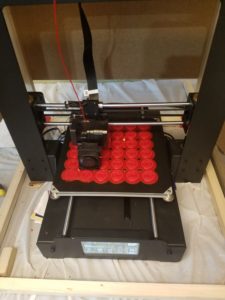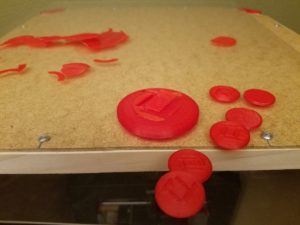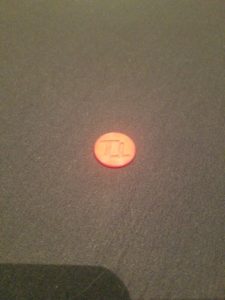Good Morning from my Robotics Lab! This is Shadow_8472, and today, I am introducing myself to the world of drones. Let’s get started.
While my ultimate goal is to print my own drone, I decided to try have my first flights on a pre-built machine. That way, any observed mistakes should be user error. I visited a local hobby shop for a fairly cheap drone. Nothing too fancy, the Invezo Stunt Drone RTF. Mine doesn’t camera but it is supposed do flips mid-air.
It was an open-package deal, so I got a significant discount. I had a short first flight, during most of which I let my sister borrow the controls. All of a sudden, it quit. Low Voltage Cutoff (LVC), I later learned. I unplugged the battery…
The black wire separated from the plug. Sure, I could just stick it back in there, but that’s not how it’s supposed to work. I did that a little, and got the USB battery charger plugged into a USB rapid charger. I read through the manual, where I learned about LVC and not to over or under charge the battery. I tried running it with the wire loose, but the drone wouldn’t respond to the controls.
Later, my father and I went in to repair the loose wire. I examined the tiny piece and concluded the pins could come out for service, but my father obviously had had some experience with such a plug before, so I followed his lead and we jammed the wire back in and pushed on the exposed part to crimp it back together…
After butchering the repair job, we took the drone back in the next day. I told them the situation, and they confirmed my suspicion about pulling out the pin to repair while making me feel like a fool by demonstrating its ability to obey the controller. We bought a replacement part and a spare battery.
The repair went more smoothly than we prepared for. First of all, the soldering iron came in and was brought up to temperature. I pulled out the pins for the replacement socket and swapped them so red would still be going to red and (blue) would be going to black.
After playing with some shrinkwrap wire jackets, I idly tried the old, good pin from the red wire, and it worked with the new socket. I used some wire cutters to cut into the old socket again and retrieved the other pin. That pin was the hardest part of the repair. My father sent it flying twice while trying to hold it with the needle nose pliers, and both times, I found it within seconds, the first time, I heard it hit the hardwood floor. The second, I spotted it in my lap on the way to look for it on the doormat.
We ended up pulling a three handed operation and crimped the old pin onto the old wire and after I had given up on account of it being squished just a little bit too far past the crimp proper, my father managed to get it stuck in there.
I had a battery on the charger, this time in an actual computer (The old machine I gave my new SSD to and named Derpy Chips (I was wondering how long it would take someone to notice the name…)), like the shop guys said. I charged up one battery, then the other and started flying the thing around the house.
Drones are clumsy. At least at first. Elevation is super hard to keep steady, as are forwards and backwards. There is supposed to be some adjustment available on the controller for each axis of motion (Forward and Backward, Left and Right, and Yaw(rotation) left and right.), but throttle is on the pilot.
Running into obstacles seems to be a staple of learning to pilot a drone. This is where this model’s ability to flip comes in handy. Every little nick messes with the rotation, such that I lost track of where what part on it was facing. The orange and black propellers help point forwards, though.
Hair in the propellers seems to be worth a paragraph in and of itself. Hair gets stuck, it stops the propeller, the drone stops. A partial slow is also possible, though, and can introduce an annoying, diagonal drift in your otherwise perfectly balanced hover settings.
Problems aside, my family’s small dog took an interest in the tiny hovering creature, going so far as to try to socialize with it like a cat. While curious about it, she didn’t appreciate it approaching. If she got too close, I could just jam the throttle up and get it out of the way.
Final Question: What is a favorite time one of your animals interacted with your technology to humorous ends?


 I did a pair of test prints and decided the 1 in. coins would be neat to hand out to everyone at the meet and greet, so at present, I’m printing up 36 of them at once. The raft is finishing up, but there are two spots where I think the coins will be lost. The first little bit of the raft just didn’t stick in that area. If those were solo prints, I’d abort them, but I’m not going to do so at the cost of the others.
I did a pair of test prints and decided the 1 in. coins would be neat to hand out to everyone at the meet and greet, so at present, I’m printing up 36 of them at once. The raft is finishing up, but there are two spots where I think the coins will be lost. The first little bit of the raft just didn’t stick in that area. If those were solo prints, I’d abort them, but I’m not going to do so at the cost of the others. My stunt failed. I think the way I modeled it is to blame. The middle detail between the relief peeled. One of the eight smaller coins didn’t peel from the raft. In the end, I’m taking 42 coins to pass out.
My stunt failed. I think the way I modeled it is to blame. The middle detail between the relief peeled. One of the eight smaller coins didn’t peel from the raft. In the end, I’m taking 42 coins to pass out. The Tango Tokens were a hit. Even though they weren’t perfect, they made for a cool, little souvenir for everyone. If I ever make more, I will want to remodel the coin and fuse all the pieces before they leave Blender. The printer was printing an internal membrane which led to the weak spot. On the other hand, maybe I can label future tokens with the event meetup. When I hold pretty much any 3D printed object to the light, I can see the infill lines. I want to try inserting a label in there to differentiate the production runs.
The Tango Tokens were a hit. Even though they weren’t perfect, they made for a cool, little souvenir for everyone. If I ever make more, I will want to remodel the coin and fuse all the pieces before they leave Blender. The printer was printing an internal membrane which led to the weak spot. On the other hand, maybe I can label future tokens with the event meetup. When I hold pretty much any 3D printed object to the light, I can see the infill lines. I want to try inserting a label in there to differentiate the production runs.